Inside: Find out some successful strategies for a positive classroom management plan that you can start immediately to build a safe and supportive environment.
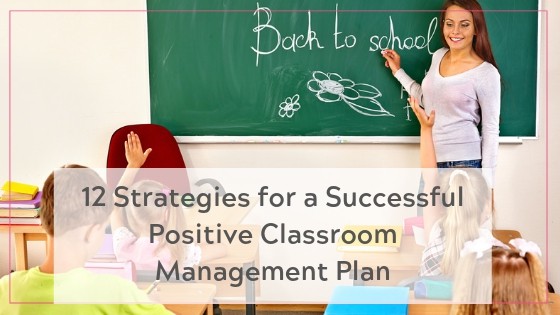
As a teacher, you will need to be a clever manager of your class and students within it. For this to happen you will need really smart strategies to implement for your positive classroom management plan.
As teachers, we teach explicit lessons. We look after children. We manage their behaviour and the things that happen in the classroom. We need to know how our students learn. We need to know how each of the students is doing. We need to build positive relationships. We are mothers, helpers, nurses, psychologists and a listening ear.
Wow! and this is every day!
So getting an effective classroom management plan together can make your day a whole lot easier. But it takes time and experimentation before you will know what will work for you.
Each year it can change too, depending on the cohort of student you have. It also comes back to your own philosophy of behaviour management.
I believe that if you can get your classroom management system established and automated, your days in the classroom will run much more smoothly.
You will then have the energy to focus on the more time-intensive tasks that are required each day like; marking, lesson planning and reporting and reading and responding to emails, just to name a few.
This post contains affiliate links. For the full Disclosure Policy see here.
Steps to make your classroom management plan successful.
For positive classroom management plan to work effectively, hopefully, you understand that it is necessary to have clear and explicit instructions in place that you follow each and every day.
You need to be sure of your plan so your students can follow it.
Tips to implement your classroom management plan
1. Teach your behaviour management plan to your students.
2. Display clear and explicit charts around the room that outline your clear expectations so that your students have a visible reminder of what behaviour is expected of them.
3. Talk about your behaviour expectations all year and follow through with it consistently. It’s the only way it will work!
I remember back to my first term out of university. OH. MY. GOODNESS. My behaviour management was non-existent.
If you came anywhere near my room, all you would hear was me screaming. “Sit down!” ‘Stop talking!”
The children were definitely in control. I wasn’t!
It was awful. I was desperate to find something that worked. I remember that I went home every night in tears, complaining to my husband how difficult it was. Do you relate?
If you need help with a behaviour management plan, I thoroughly recommend reading a wonderful book called Assertive Discipline: Positive Behavior Management for Today’s Classroom (Building Relationships with Difficult Students). It’s a must-read and helped me so much.
Because my first placement was so bad, I knew that I needed to become a better classroom manager and make my life easier as a teacher, otherwise I wouldn’t last long.
So, all of the following strategies that I will share with you, I’ve collected together from a variety of sources, and I know they work.
By implementing them consistently, they have made me a much more effective teacher. You need this list of successful positive classroom management strategies in your room too!
I use them effectively every day in my own classroom.
Each strategy can be quickly implemented to build a positive and supportive environment for any class. Try them now!
*** Don’t worry if you haven’t initiated them at the beginning of the school year, it is very easy to implement and teach at any time of the school year.
A successful positive classroom Management plan
1. Classroom Rules
It is your number one priority as a smart class manager to have a clear set of Classroom Rules that are explicitly taught to your students.
Class Rules are generally set by the class teacher and should state the required behaviour that you need from each student.
As the students get older you can negotiate your set of whole class rules and find out what is important to them specifically. It helps the students take ownership of their behaviour because they were involved in the rule creation.
Research tells us to limit our rules to maybe 5 or 6 succinct instructions starting with a verb.
I use rules that explicitly state the behaviour I’m looking for. For example
- Listen and follow instructions
- Raise your hand and wait to speak
- One person speaks at a time
- Speak politely and use your manners
- Use all equipment safely
I find these explicit rules are much better for classroom management than statements like Show respect or Be happy because they clearly state the behaviour that is required.
Our school has overarching values of Respect, Kindness, Honesty, Cooperation, Self-Discipline, Learning and Social Justice, that I link my classroom rules to.
If you have whole school rules or values tailor your classroom rules specifically to these, as I have.
Related Article: Clever Classroom Rules: Tips for Teachers
2. Clip Behaviour Chart
I find an easy way to monitor and reward individual student behaviour is by using a behaviour clip chart that is displayed in a visible spot in your room.
Some teachers ask if they should use a behaviour chart and want to know if it works.
Well, the answer is yes, I have had great success using one for many years now.

In my classroom, I use a chart that is stepped to encourage positive behaviour and has rewards and consequences built into each step.
To describe how it works: Each student has a named peg that is clipped to the chart. Students start each and every day in the middle at ‘Ready to Learn’, no matter what happened on the previous day.’
As the teacher identifies different student behaviours throughout the day, students are asked to move their pegs accordingly; up for positive behaviour and down for negative behaviours.
It is a quick and easy way for you to monitor your student’s individual behaviour, which the children can use to work on individual goals. This rewards each student for their effort and good behaviour choices.
At each level above the starting point (Ready to Learn), you will have specific rewards set up, for example, stickers, certificates (positive notes homes) or priveledges.
At each level below the start, set consequences like class time out, buddy classroom, or parent conferences.
All of these instructions should be clearly outlined in a poster and introduced at the beginning of the school year so that the students know how the system works. Get your FREE downloadable behaviour chart from the Resource Library.
Copy it onto coloured cardboard and then laminate. I then punched holes into mine and used string to make a chart – easy!
You might need help with the noise levels in your classroom. Get you FREE Voice Levels poster here:
3. Rewards System

Many education theorists encourage educators to develop their student’s intrinsic motivation to achieve success. Many believe that rewards don’t develop internal motivation as they reward extrinsic factors.
But, any good classroom manager knows that developing this internal driving force can be more difficult with younger children.
Extrinsic rewards work really well in any primary setting and also lower secondary. This type of rewards system can help develop the deeper motivations in your students as well as have some fun in the process.
Implementing a Rewards System
Over the school year, I use a variety of rewards in my classroom and I change them up over the year.
Here are some of the rewards that work well for grade 5 and I know work for younger students too.
- Sticker charts
- ticket system – a system of classroom currency
- classroom cash/bucks
- raffle tickets that are drawn out of a box for prizes
- certificates – I use a variety of certificates: daily, weekly, end of term and end of year
- prizes
(Don’t think stickers won’t work for older grades. My son has used the coveted ‘scratch and sniff’ variety of stickers for grade 8 and 9 and they love them!)
Having a reward system that acknowledges individual behaviour, as well as rewarding whole class effort, are all great methods of developing responsible behaviours in your students.
4. Marbles in the Jar
As part of a whole class rewards system, I use what’s called ‘Marbles in the jar’. It’s a really useful way to reward the whole class when they are working well together.
It works as a more medium-term goal to work towards and builds class belonging, whole class cooperation and a sense of ‘class spirit.’
How it works: When the jar is full by an agreed time-frame (I have a time-frame goal of 5 weeks (midterm), the whole class receives a reward. This incentive is decided by a joint class agreement. (usually in a class meeting – see strategy 9).
When the students are all working well together as a class and are on task or they walk quietly together between classrooms or anything they do together etc, I add marbles to a jar.
Some of my previous classes have come up with some terrific incentives; for example, class parties, a movie and popcorn session, games sessions (outside and inside), pyjama days (actually I haven’t done that one yet, but I think it’s a great idea) and many others.
In one of my year 5 classes a few years ago, I had an empty fish tank in the classroom. I would tell my students that when the marble jar was filled I would buy the fish to put in it. It worked so well and was a huge incentive for whole-class on-task behaviours.
5. Attention Getters
A great class management strategy is to have some consistent ways to grab your student’s attention.
- Using fun callbacks, that the students know and learn, are a quick way to gain their attention. Callbacks also save valuable learning time, which we all know is key.
I use one or two different call-backs each term. You can change it up and teach them new callbacks whenever you like.
Read my post for some great examples of 10 Fun Attention Getters for the Classroom, with a free printable call-back poster. Download the colourful chart FREE from the Resource Library.
- Another easy attention-getter can simply be a noisemaker of some sort. I use a maraca, but you could use a small bell to ring, or another musical instrument; like a whistle. This sound-maker is necessary for classroom management to quickly gain the student’s attention, without the teacher having to yell out. The musical noisemaker is a must to gain student attention in more noisy situations. For example when the students are occupied in cooperative small group activities.
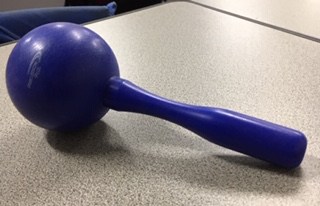
6. Noise Meter or Voice Levels
An important classroom management strategy in any classroom is to monitor the amount of noise that the children are making in your room, especially in small group activities.
To have this working well, you need a system to teach the management of noise or voice levels. I use a Voice levels chart that has a numbering system matched with the type of classroom talk being undertaken.
This is a great way to explicitly teach students the level of talk and noise that is acceptable in each situation. Modelling examples of each voice level will also be needed.
For example: in a test or at assessment time, you tell the students that they will use voice level 0 – No talking or silence; or in a paired learning activity, “We will be using voice level 2 – Quiet talking – “your partner should be the only one to hear your voice”.
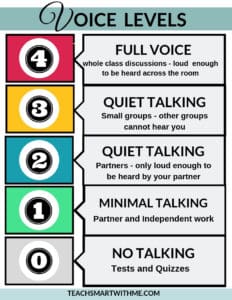
This is a terrific system of managing the noise level in your classroom if it is used consistently and modelled.
Download a copy of my FREE printable chart here:
7. Classroom Jobs
In any good classroom management plan, it’s very important to involve your students in the running of the day-to-day tasks of the classroom.
This helps lighten the exhaustive load on the classroom teacher as well as developing responsibility in your students.
A great way to get student involvement is to designate the classroom jobs to students to manage.
I use a simple system where I take volunteers or just randomly draw names from my ‘pick a stick’ to look after basic jobs like; lights and fans, opening and closing the door (we call it our classroom butler), whiteboard cleaner and resource collectors and handout people.
I know a lot of teachers use student jobs in the classroom, but understand that I see this is a strategic move to help reduce teacher workload.
If you are a new teacher or haven’t utilised this management strategy, start today!
Related Article: Classroom Job: How to Effectively Use Student Helpers
8. Pick a Stick – with named paddle pop sticks
To make it easy to call on students and ask for volunteers I used a system of paddle pop sticks that are labelled with each student’s name. It’s is a great way to randomly draw out their names when you need them. I put all the sticks into a cup for easy access.
‘Pick a stick’ can be used for :
- calling on any students to respond to teacher questions in a lesson (avoid the ‘hands up if you know the answer’ and ensures all students are listening and involved
- drawing out student helpers for classroom jobs
- pairing up students for buddy work – eg. reading partners and many other things
9. Class Meetings
Having a regular time for class meetings works well for classroom management. It helps students to understand that they have a voice and they can share their ideas and thoughts with the class and be valued for their opinions.
In our regular (weekly) class meeting, we have discussions about what’s going well; questions that students are having and decisions that need to be made as a whole class, (like what reward needs to be decided on by the whole class after achieving a full marble jar).
10. Build Relationships with your Students
Research tells us that building personal relationships with each and every one of our students is a key strategy to be more successful with your behaviour and classroom management.
Your students won’t know how much you care until you take the time to find out who they are and get to know them.
Let them know about you as a real person too.
At the beginning of each school year, I tell my students about me and my family. I have a photo of my kids on my desk and I regularly talk about my own life and what I like to do.
Sharing these details really helps to relate to them on a personal level.
Related Article: Easy Back to School Activities for Teachers to get to know Your Students
11. Regularly Move Student Desks
I like this classroom management strategy because it gives all of your students a chance to work from different positions in the room.
It also helps the students to build relationships with all of there class members and develop cooperation skills, as well as helping to monitor behaviour and dynamics between students.
Plus, if they know that you move desks regularly, students will know that they are not stuck at the same desk all year. It also makes it a bit more interesting. (I use fun activities like musical chairs to change desks or just the ‘pick a stick. Sometimes I might just position them myself.)
Desk arrangement is another area to discuss here. I like starting the desks in rows, as I believe I get better lesson engagement, but later in the year, I put the desks into small groups to help with cooperative learning.
12. Deal with Lost Property Easily
Have an ‘I’m lost’ bin for lost property. (I got this idea from Miss Giraffe’s Class, who was giving out printable labels for the lost bin).
A designated place for all classroom lost belongings is a clever way to save time managing students belongings.
At the end of the school day, all unclaimed belongings or equipment is placed into the bin.
On a weekly basis, go through the items in the bin with your students to see if they are claimed.
This approach saves so much time and removes any responsibility the teacher feels to find owners of belonging every day.
Use these strategies and be a successful classroom manager today!
Remember you’re worth it!
Michelle x
PIN IT FOR LATER
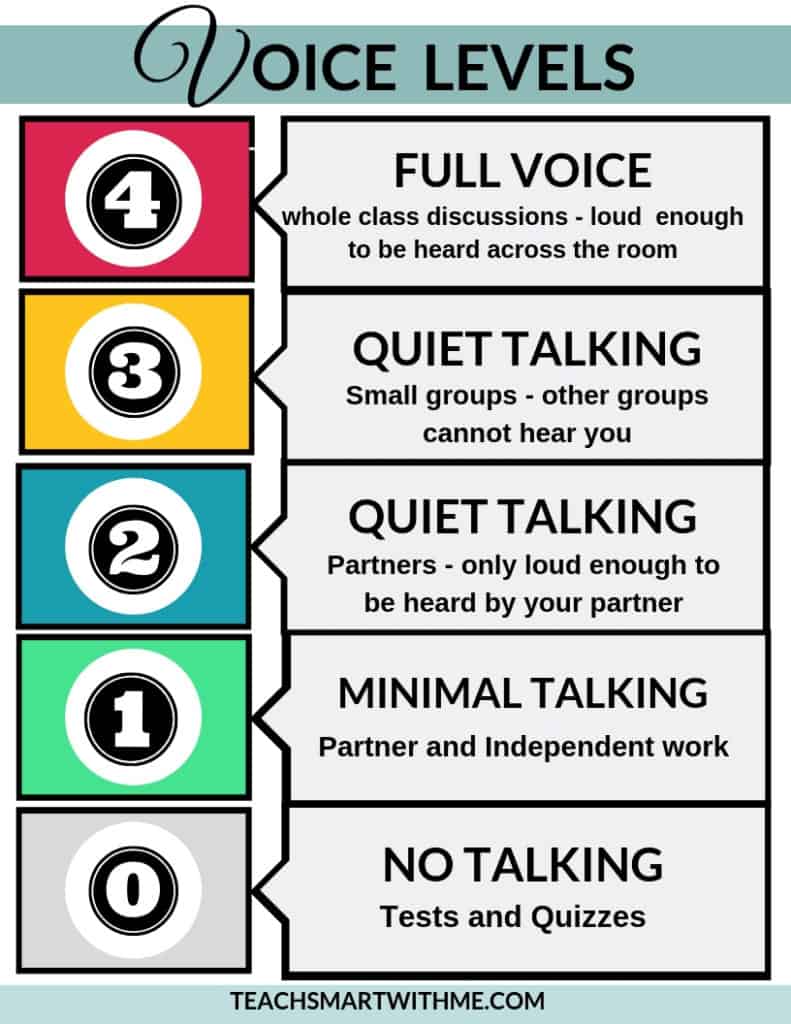
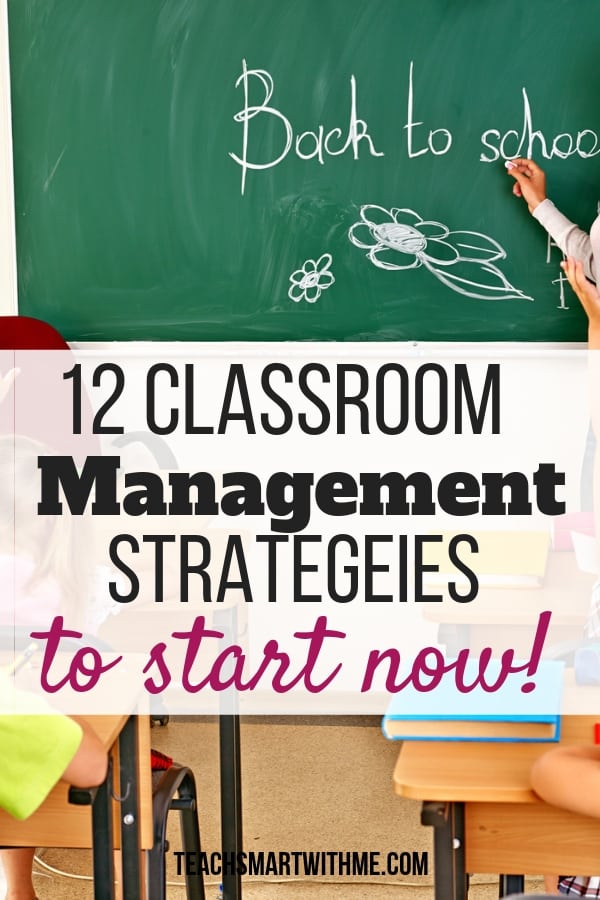
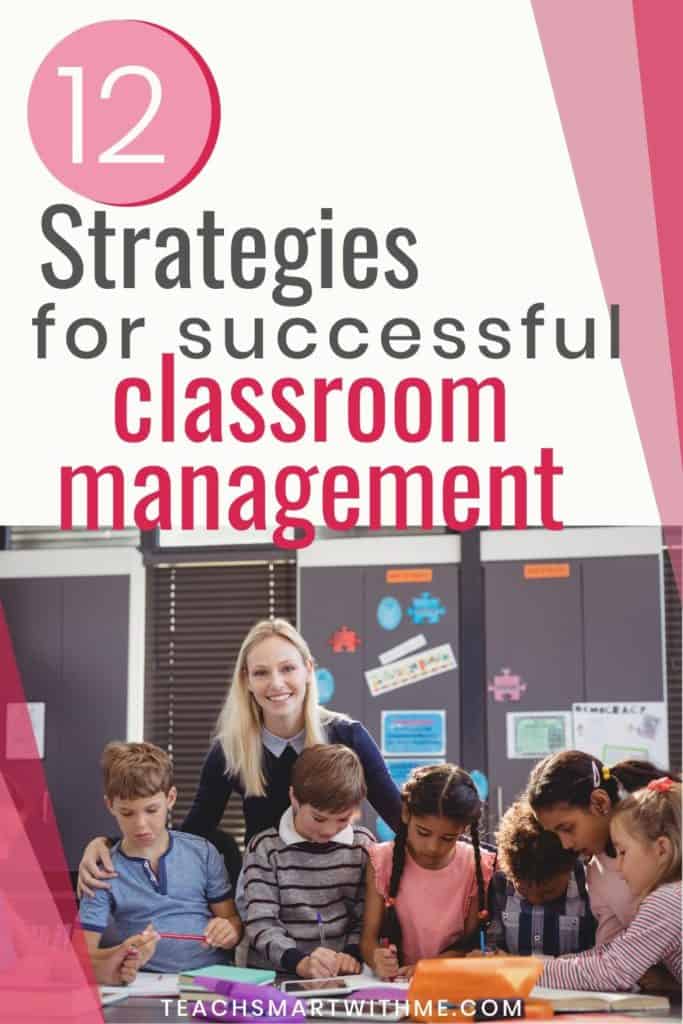
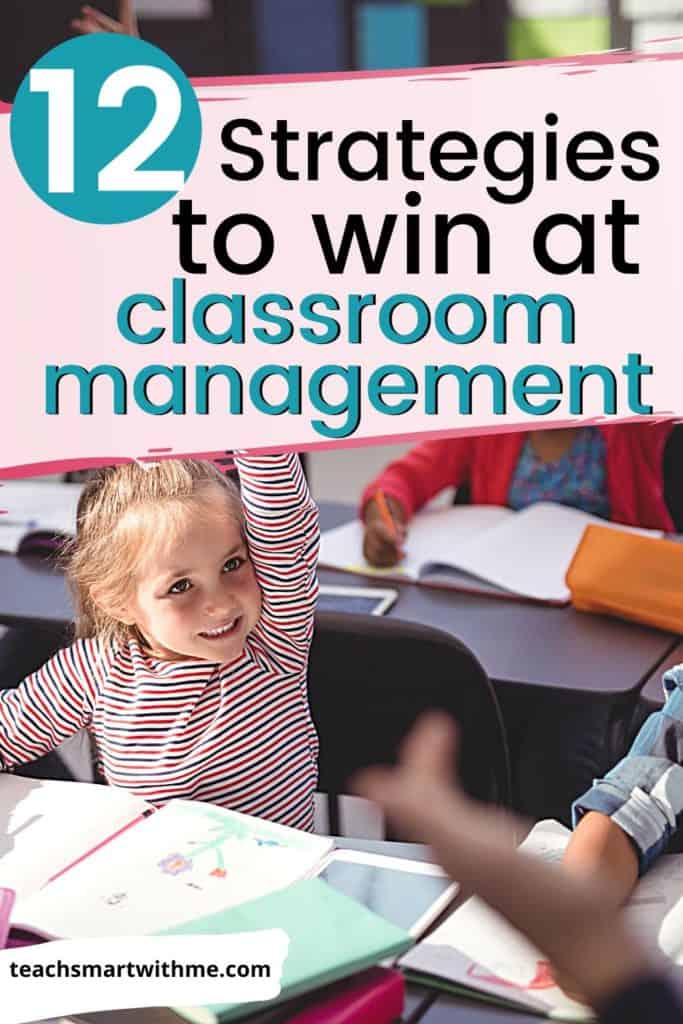
Other Classroom Management Articles
https://teachsmartwithme.com/10-fun-attention-getters-to-gain-your-students-focus/


I agree with the rotation system of their desks. It allows them to collaborate more with their classmates and create new friendships.
Totally agree! Thansk for sharing. 🙂